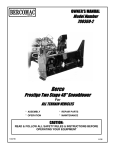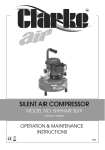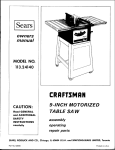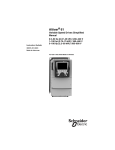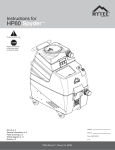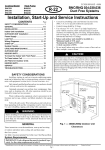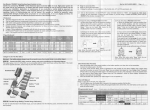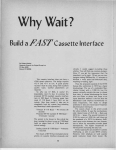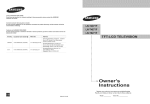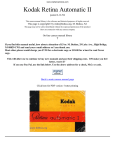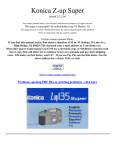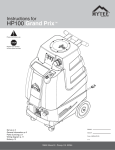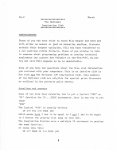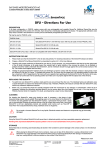Download Kodak Folding Hawk-eye B No 2-2A
Transcript
www.orphancameras.com
www.orphancameras.com
Outdoor Exposure Guide
for cameras fitted with
Hawk-,Eve Lens
Sun;ecr
Nearby
or no
open
Street
landscapes showing little
sky. Nearby subjects in
field, park
or garden.
scenes.
Srop
OpBwrNc
U.S. 8
Ordinary landscapes showing sk)',
wifh a principal object in the
foreground.
u.s. 16
Marine and beach scenes. distant
lahdscapes, mountains.
Snow
dark
scenes r,vith no prominent
objects in the foreground.
u . s .3 2
Portraits in the open sliade, not
under trees or the roof of a
porch. Shaded nearby scenes.
and slightly
Narrow
shaded
streets.
US 32
Moving objects.
When photographing
a moving
object such as a runner, train
or an automobile, the subject
should be traveling towards or
away from the camera at an
angle of about 45 degrees.
P'icture tak'ing up'iththe
.
the
SnurrBn
SpBBo
r/2s
d
:
Nos. 2 and 2A
Foldirg Cartridg.
H awk-E\'. Cameras
Model B
Hawk-Frre I-ens
one
second
r/so
This exposure table is for the hotrrs from 2)4 hours after
sunrise until 2/z hours before sunset on days when the sun
is shining. If pictures are made earlier or later in the day,
or if it is a sliehtly cloudy or hazy day, use the next larger
stop opening than the one specified.
The largest stop opening is U.S. 8. The hieher the number
the smaller the opening.
,\
\
EASTMAN KODAK COMPANY
R o c H B s r E RN, . Y .
www.orphancameras.com
..KODAKERY''
P'icture taking w'ith the
rnHIS
most interesting ?nd profusely
l- illustrated monthly magazine shows
how to make better pictures, and describes
many novel and unusual methods of making
photographs. Anyone who buys an Eastman
camera is entitled to 'Kodakerv." free of
charge.
Nos. 2 and 2A
Folding Cartridge
Hawk-Eye .Cameras
Return the post card included with this
manual, properly filled out, and your name
will be put on the mailing list, to receive
"K o d a ker y . "
"Kodakery" will be sent for six months on
this offer. A post card will be enclosedwith
the fifth copy; if this post card is filled out
and returned to us, it will entitle you to an
additional six months, free of charge. After
that the subscription price will be sixty
cents for one >/ear, or one dollar for two
years, but you are under no obligation to
renew.
Send us the card promptly, and start
enjoying "Kodakery" at once. There is no
charge; no obligation.
EASTMAN
\*
KODAK
COMPANY,
RocnBsrBn, N. Y.
Model B
Hawk-Eye Lens
II
I
t
I
t
1
{
;
{
Published by
EASTMAN KODAK COMPANY
RocnBsren,N.Y.
,l
il
t
t{
{
'
{l'"
--,
www.orphancameras.com
IMPORTANT
THB CnnrBnR
T) EFORE taking any pictures with ygur
D camera,and before loading it with film,
r""a and follow these instructions carefully.
Take especialcare to learn how to operate
the shutter.
While loading and unloaditg, be very
careful to keep [|e protective paper wound
tightly around ths film to prevent light
st?iking it. The camera can be loaded or
unload[d in daylight. This should be done
in a subduedliiht, not in direct sunlight'
To Loeo
1-Sliding Lock
2-Locking l-ever and
Support
3-Knob on Slide Plate
4-Lens Standard
S-Focusing Scale
6-Shutter
7-Lens
g-Finder
9-Winding K.y
1O-Bed
1l-Side Arnr Locks
A-Speed Indicator
B-Stop Opening Lever
C-Exposure Lever
D-Cable Release
_f
Slide back the
lock. Take the
front of the camera by the edges
and lif t the
end on wh i ch
www.orphancameras.com
the lock is fastened,
drawing out that
part of the camera
as illustrated.
Draw out the
winding key as far
as it will come, and
remove the empty
spool.
Remove the paper band, unfold the end
of the protective paper and thread it as far
as ,it w,ill go, into the longer opening of the
slit in the empty spod. Each spool has one
4
end slotted and the protective paper must
be inserted in the empty spool so that the
slottedends are on oppos'iteedgesof the paper.
The word "TOP" piinted on the protective
*w
tq
paper must be next to the slotted end of
the reel. Give the empty spool three or
four turns, enough to bind the paper on
the reel" The paper must draw straight,
and the full spool must not loosen.
Place the two spoolsinto the film pockets
at each end of the camera, keeping the
paper taut, 3s shown above.
www.orphancameras.com
Important.'
The empty spool or reel
must be placed in the winding k"y end of
the camera with its slotted end,towards the
wind'i,ng key.
Push the full spool into the other pocket
as f.ar as it will go, so that the tension
spring grips it.
Press in and turn the winding k"y until
it fits into the slot in the empty spool or
reel.
I
Press in and turn the winding k"y and
watch the red window. After a few turns,
a warnittg hand will appear, then turn the
key slowly until the figure 1 is in the center
of the window.
I
The film is now in position for the first
exposure. After each exposure be sure to
wind the film, bringitg the next number
into place. This prevents makittg two pictures on the same section of film.
Af ter the camera is loaded, replace the
front, first inserting the end opposite the
lock; the edge of the box must fit into the
groove on this end of the front. Press
the end on which the lock is fastened into
place, and push over the lock.
www.orphancameras.com
OpBxrNGTHB Fnoxr oF Cavrpna
Raise the lever
near the winding
k"y, and d raw
down the bed of
the camera, until
the side arms
catch.
Draw out the
lens standard by
the knob on the
slide plate, to the
slot marked 100
feet, where it will
lock automatici
ally.
A-Speed Indicator
B-Stop Opening Lever
C-Exposure Lever
Release
D-Cable
Instantaneous ExPosures
t'snapshotst t
Move the indicator A to 25 or 50 accorditrg to the time of Instantaneous Exposure
required.
Move the lever B to the correct stoP
opening, seeExposure Guide on back cover,
or table on pages 14 and 15.
Press the push-pin of the cable releaseD
or press the exposure lever C. Th,is makes
the exposure.
www.orphancameras.com
Time Exposures
Move the indicator A to the letter "T"
(time).
Move the lever B to U.S. 8, 16,32 or 64
depending on the time of the exposure and
the nature of the subject. See tables on
p a g e s1 4 , t 5 , 2 7 , 2 8 a n d 3 2 .
Press the push-pin of the cable release D
or press the exposure lever C. This opens
the shutter. Time the exposure by a watch.
Again press the push-pin or the exposure
lever. This closesthe shutter.
For short time exposures of ten seconds
or less,"Bulb" Exposuresare recommended.
ttBulbtt Exposures
Move the indicator A to the letter "B"
(b u l b ).
Mo ve t he lev er B t o U .S. 8 , t6 ,3 2 o r 6 4 .
S e eta b l e s on pages14, 1 5 , 2 7 ,2 8 a n d 3 2 .
Press the push-pin of the cable release D
or press the exposure lever C, to open the
shutter, and release it to close the shutter.
This makes the exposure.
IVever make T'ime or "BuIb" Exposures
with the carneraheld,'in the hand,s.
Neztero'il the shutter.
Important:
In case of accident, return the camera
to your dealer or to us for repairs.
10
To Focus rHE Ceupne
On the bed of the camera is a focusing
scale,with slots marked 8,25 and 100 feet.
The scale is marked both for feet and
meters and care should be taken not to
confuse the figures.
When the lens standard is drawn out to
the slot marked 100 feet, the camera is in
focus for anything 100 feet or beyond.
To adjust the focus for subjects at dis
tances nearer than 100 feet, press the spring
catch or locking device on the side at the
bottom of the lens standard, and draw out
the standard to the slot marked 8 or 25,
depending upon the estimated distance
between the camera and the princ'ipal
object to be photographed, see Depth of
Focus Tables on page 13.
The distance between the subject and
camera can be estimated without measuring, unlessthe subject is closeto the camera;
foi instance, if the focus is set at the slot
marked 25 feet (the usual distance for ordinary street scenes), everything-from about
fouiteen feet to about seventy-five feet will
be in good focus. When the camera is
focused-in this manner, it may be used as
a regular fixed focus camera' see-page 12'
\,Vheh the principal object is nearby or at a
LT
www.orphancameras.com
great distance, the focus should be changed
accordingly.
For distant views, set the indicator in
the slot marked 100 feet, and when the
subject is about eight feet from the lens,
set the indicator in the slot marked eight
feet. When the camera is focused for eight
feet, the subject can be about five feet from
the camera if the smallest stop opening is
used, see table on page 13. A time exposure
will be necessarywhen using the smallest
stop opening. The subject can be closer
than five feet to the lens if a Kodak Portrait
Attachment is used, see pages 30 and 31.
How to Use the No. 2 or the No. 2A
Folding Cartridge Hawk-Eye
as a Fixed Focus Camera
SBr rnB Focus tr 25 FBBI.
MovB Srop Oppxrxc LBvBn ro U.S. 8.
U sB S pB B o 25.
When using the camera as a fixed focus
type, nearby subjects must be in bright
sunlight, to obtain fully exposed negatives.
The range of sharpnesswhen your HawkEye is adjusted as a fixed focus camera 'vill
be found in one of the tables on page 13,
t2
DBPTH OF FOCUS
.
Depth of focus is the distance from the
treareit to the farthest objects that will
appear sharp in the negative or print. The
d-epth of focus of any lens depends upon the
siz-eof the stop opening used. The smaller
the stop opening the greater the depth of
focus. See the following tables for the depth
of focus or range of sharpnessof the Nos. 2
and 2A Folding Cartridge Hawk-EYe
C ameras:
the No. 2 Hawk-Eye
Table for use with
Srops
u.s. 16
U.S. 8
Distance
Focused
Upon
RANGE
Table for use with
Srops
Distance
Focused
Upon
Ft.
Ft.
13 to Inf.
9% tolnf.
5)4 to l8
the No. 2A Hawk-Eye
u.s. 16
U.S. 8
RANGE
u.s. 64
OF SHARPNESS
I.-t.
Ft.
to Inf.
t7
Ll% to Inf.
6 to 13
100 Ft.
25 Ft.
u Ft.
Carnera
u.s. 32
u.s. 32
Camera
u.s. 64
OF SHARPNESS
100 Ft.
25 Ft.
8 Ft.
is the abbreviation
"Inf."
distance from the lens.
for Infinity-meaning
an unlimited
Srop OpBurNcs
The stop openingsregulate the amount
of light passingthrough the lens. The open-
www.orphancameras.com
.f
ings are enlarged or reduced by moving the
lever B, see page 9.
These stop openings are marked with the
"U.S." or Uniform System which is based
on the relation betrn'eenthe area of the stop
and the f ocal,l,engthof the lens. Stop U.S. 8
is the largest opening and admits the most
light. U.S. 16 is half the size of U.S. 8 and
admits just half as much light and so on
for each higher number (smaller stop openitg ).
The exposures must be doubled for each
succeeding higher number (smaller stop
opening). For example: If the correct exposure using stop U.S. 8 is speed 50, the
equivalent exposure using stop U.S. 16
will be speed 25. See comparative exposures using different stop openings given
on page 27.
U.S. 8-For all ordinary outdoorpictures,
such as nearby landscapesshowing little or
no sky, groups and street scenes,when the
subject is in bright sunlight, use speed 25;
for moving objects in bright sunlight, use
speed 50.
U.S. 16-For open views, when the sunlight on the subject is unusually strong
and there are no heavy shadows, such as
14
t
I
i
views at the seashore and on the water,
use speed 50; for ordinary landscapes, in
bright sunlight, with clear sky overhead,
use speed 25; also for Interior Time Exposures, the time for which is given in the
table on page 28.
U.S. 32-For instantaneous exposuresof
extremely distant landscapes,marines, snow
scenes with no prominent dark objects in
the foreground, and clouds only, in bright
sunlight, use speed 25; also for portraits
outdoors, see pages 29 and 30, and other
Time Exposures.
U.S. 64-For Time Exposures Outdoors
on cloudy days, see page 32. For portraits
outdoors, seepages29 and 30 ; and for Interior
Time Exposures, see page 27. Neaer for
instantaneous exposures.
The smaller the stop opening the greater
the depth of focus, see page 13.
Fa'ilure will result, if stop U.S. 64 is used
f.or instantaneousexposures.
Al1 the exposures given for outdoor subjects are for the hours between two and a
half hours after sunrise and two and a half
hours before sunset. If earlier or later the
exposures must be longer. For subjects in
the shadow, under porches or under trees,
www.orphancameras.com
t
no definite directions can be given; experience only can teach the correct exposure
to give.
No. 2 Folding Cartridge
Hawk-Eye
,^,
(
\_/
) u.s.8
( ) u.s.16
O us.se
O
u.s.64
COPYRTGHT I922
EASTMAN KODAK
BY
CO.
THB FrunBR
The finder shows what will appear in the
picture, but on a much reduced scale.
ng Cartridge
Haw k-Dye
.l
u.s. I
\,/
oC
o
-W
u.s.16
u.s.32
u.s.64
These circles are the same size as the
stop openings of the shutters on the Nos. 2
and 2A Folding Cartridge Hawk-Eye
Cameras, when they are fitted with the
Hawk-Eye Lens. They show the relative
sizes of the stop openings and how their
areas differ.
Look into the finder from directly over
the center of it and include what is wanted
by turning to the right or left, see illustration on page 18.
To make a vertical picture, hold the camera as
shown above. The view
included will appear in that
part of the finder represented by the white portion
in the diagram.
t7
www.orphancameras.com
To make a horizontal
picture, turn the finder and
hold the camera as shown
above. The view included
will show in that part of
the finder represented by
the white portion in the
diagram.
MerrNG IxsrnNTANEous ExposuRBS
OR STV,TPSHOTS
When making instantaneous exposures
or snapshotswith any camera, hold it firmly
against the body as shown. When pressing
the push-pin or the exposure lever, hold
the breath for the instant. If the camera
is moved during the exposure, the picture
will be blurred.
18
When ordinary instantaneous exposures
or snapshots are made, the subject should
be in the broad, open sunlight, but the
camera must not" The sun should be behind your back or over the shoulder. If it
shinesdirectly into the lens it will blur and
fog the picture.
Special instructions for making -portraits
a r e g i v e n o n p a g e s2 7, 2 9 , 3 0 a n d 3 1 .
79
www.orphancameras.com
Horo rHE CnuBn,t LBvEL
The carneramust be held level. If all the
subject cannot be included in the finder
without tilting the lens upwards, move
backwards until it is all included zv,itlt,th,e
camere,/teld,leztel"
Turn the winding key
slowly, a few times, until
No. 2 is in the centerof
the red window.
After all the exposures
have been made,turn the
k*y until the end of the protective paper
passes the window. The film is now ready
for removal from the camera.
CroslNG THE Cevrpna
Release the spring catch on the lower
part of the lens standard, from the slot in
the focusing scale, and slide back the lens
standard as far as it will go.
Place the cable release around the shutter, press the arm locks at each side of the
standard and raise the bed.
Efect produced by ti,lt'ing the camera.
If the subject is below the normal height,
like a small child or a dog, the camera
should be held down level with the center
of the subject.
20
Caution: The lens standard must be
pushed back as far as ,it zu,illgo, or it will
interfere with the bed when closing.
2l
www.orphancameras.com
RBvrovrNG THE Fruvr
After the last section of film has been
exposed, turn the winding k"y until the
end of the paper passesthe red window.
In a subdued light, remove the front of
the camera as described on pages 3 and 4.
Marks: After removitrg the
"Cinch"
film from the camera, do not wind it tightly
with a twisting motion, or the film might
be scratched.
#*
'Enr','n
Hold the end of the paper taut and turn
the k.y until all but about an inch of the
paper is on the ro11.If the sticker folds
under the roll, turn the winding k"y to
bring it up.
Take hold of the ends of the paper and
sticker to prevent paper from loosening.
Draw out the kev and remove the roll of
film. Fold under about half-an-inch of the
protective paper, and fasten it with the
sticker.
22
Wrap up the exposed film. It is now
ready for development. This rnay be done
by a photo finisher, or by yourself. If the
latter is desired, you may write to our
Service Department, mentioning the size
of the pictures made with your camera,
and we will send you a list of the necessary
materials which Can be ordered from yo,rt
dealer.
Film should be developed
Important:
as soon as possible after exposure. The
quality of the image on all sensiti zed products is retained by prompt development
after exposure.
2s
www.orphancameras.com
Remove the empty spool and place it in
the winding end of the camera.
Replace the front of the camera as described on page 6.
The camera is now ready for reloading.
It is a good plan to reload the camera as
soon as an exposed film has been removed,
to be ready for the next pictures. Load with
Kodak Film.
the picture. If all the windows can not be
avoided, draw the shades of those within
range of the lens.
TluB ExposuREs-f NDooRS
Open the front of the camera as described
on page 8. For time exposuresthe camera
must always be placed on a firm support
like a tripod, Optipod, table or ihair,
neaerhold it in the hands. It has two tripod
socketsfor use with a tripod or an Optipod.
Place the camera iq such a position that
the finder will include the view desired.
The above diagram shows three positions
for the camera. It should not be pointed
at a window as the glare of light will blur
If the camera is placed on a table, use
the locking lever 2, as a support. The
camera must not be more than two or three
inches from the edge of the table.
For horizontal pictures, turn the camera
finder and locking lever 2, as on page 26.
Focus the camera as described on pages
n and 12.
Adjust the shutter for a time exposure,
see page 10.
All being ready, press the push-pin or
the exposure lever carefully, once to open,
24
25
www.orphancameras.com
time the exposure by a watch, and again
press the push-pin or the exposure lever to
close the shutter.
suresare to be made, adjust the shutter for
an instantaneous exposure, see page 9.
Another method of making time exposures is to hold the hand or a card close tcr
the shutter, open the shutter and take the
hand away for the length of exposure required, return the hand and closethe shutter.
See illustration at bottorn of page 26.
Caution: Be careful not to touch the
lens with the hand or it will leave a mark.
Exposure Table for Interiors
The table on page 28 gives suitable exposures for varying conditions of light,
when using stop tl.S. 16.
After making a time exposure, turn the
winding key until the next number appears
in the red window. If no more tims e*po-
*:'in
":ou:3:
'\"rY'
il;:1"'
('
IJ.S. 64, t' four times
the exposures given in the table.
The smaller the stop opening the greater
the depth of focus,seepage 13. Stop u.S . 16
gives the best average results for Interiors.
To MarB
a FonrRArT
The subject should be seated in a chair
partly facing the light with the body turned
slightly away from, and the face turned
towards the camera which should be a
little higher than an ordinary table. The
subject should look at an object level with
27
www.orphancameras.com
h
E-1
a
0.)
U)
O
.ll
E I Enl
da
E
-
*
Lrr,
F{
.<lr
v l
6 l
t . i
|
-
I
| * .,l
c-.1 | e\Ol
C)
C\
.+l
|
tl
h+r
=b!
a
;x
a
a
o
a
c)
a
q)
(t)
(\
x11
a.
+)
oc)
-E(,
Ao
*6
*r:.1
-
t9
hi*
h ( ,
HO
co
sfi
X^
VY
c{
io
ll
c)
aA)
d
frl
3
a
U
o
z
|l
a
N
cd
a
a
Q
0)
o
a
,nl
a
I
c)
a
8
l
al
^l
rt)
ot
F1
o
+,
1-
u)
.<
d
i:
F =U y) do
bo
h h.Y
li
Ft!
- fr'l
aaa
-
c)
5
a
t l
b0tr
EF
F
F
X
a4
I
d
L1
-
boq
*l
co
Irr
fi
!
,,
d
CJ
t
d
-
L
a
fi
gF
sDE
-!(E
CE-
>-d9
fi'F E ?
7
P
-iE
EX
>):
o
c.)
L L
:r
rv
=b(
-
xoq
9,: H
n.=
V Y
(!
e
=-
K12h
: i L v
u*
5(/)>
a
3.i
Hb
CJ-
€'Q
L. *
troL.
a
nF
.-:
9tr(,
(aB
Fo F
EF
a
bo
cir
coU
-^
+J
(.)
-
I
bo
d
\v
\ V L
d c J
the lens, or directly at the lens. Compose
the picture in the finder. For a threequarter figure the camera should be about
eight feet from the subject; and for a fulllength figure about ten feet. When the
subject is ten feet from the camera, place
the focusing indicator in the slot marked
eight feet and use stop U.S. 16, see tables
on page 13. The background should form a
contrast with the subject; a light background
usually gives a better effect than a dark one.
To get a good light
on the face,follow the
arrangement shown
in the diagram. A
reflector helps to get
= detail in the shaded
o part of the face. A
o
z
white towel or table= cloth held by an
assistant or thrown
over a screen or
other high piece of
furniture will make
a suitable reflector; it should be at an angle
and in the position indicated in the diagram.
Making Portraits Outdoors
When making portraits outdoors, with
the sun shining brightly, the subject should
be in the shadow of a building or a large
www.orphancameras.com
tree, but with clear and unobstructed sky
overhead. Place the camera on a tripod or
other steady support, use stop U.S. 32 or
U.S. 64 and make a "Bulb" Exposure of
about one or two seconds. By following
this rule unpleasant and distorting shadows
on the face will be avoided.,
Kodak Portrait
Attachment
The Kodak Portrait Attachment makes
head and shoulder portraits. It can also be
used for photographing flowers and similar
subjects.
Place the Attachment over the lens and
compose the picture in the finder.
The subject must be at one of the distances from the camera, given in the table
below. Measure the distance carefully from
the lens to the face, and place the focusing
indicator according to the table:
DISTANCE BETWEEN
SUBJECT AND LENS
MUST BE
THE FOCUSING
INDICATOR
MUST BE SET AT
2 feet 9 inches
8 feet
3t'9"25"
4"2"100''
When making portraits, the most pleasing results are obtained with the subject
four feet two inches from the lens and the
focus set at 100 feet. For flowers and similar subjects the shorter distances will be
more satisfactory.
30
The exposure when using the Attachment
is the same as without it.
I-IseKodak Portra'it Attachment IVo.8 with
the No. 2 Folding Cartridge Hawk-Eye,
and use IVo. 3 with the No. 2A Folding
Cartridge Hawk-Eye Camera.
Kodak Diffusion Portrait Attachment
The Kodak Diffusion Portrait Attachment is a supplementary lens used in the
same manner as the regular Kodak Portrait
Attachment. It produces a true, soft-focus
effect.
Ilse Kodak D'ifusion Portra'it Attachme:nt
No. 8 with the No. 2 Folding Cartridge
.Hawk-Eye, and use -ly'o.3 with the No. 24,
Folding Cartridge Hawk-Eye Camera.
"Ar HouE wrrq rrrB KooAK" is a booklet containing many diagrams and illustrations showing various lighting effects. It
gives suggestions for making pictures, in
and around the home.
"Prctune Ter<rNc AT NIGHT" is a booklet that describes in detail the methods of
making flash-light exposures, camp fire
scenes, fi rew orks, l i ghtni ng, moonl i ght
effects. silhouettes and other novel and
unusual pictures.
These two booklets are free, and copies
of them will be sent upon request to our
Service Department.
i
www.orphancameras.com
Trprp ExposunBs-OutDooRs
When the smaller stop openings (U.S. 32
or U.S. 64) are used, the light passing
through the lens is so much reduced that
very short time exposures outdoors may
be made.
For short time exposures as described
below, use the "Bulb" Exposure,seepage 10.
With Light Clouds-From
one to three
secondswill be sufficient.
With Heavy Clouds-Four
seconds to
eight secondswill be required.
With
Sunshine-Time
and "Bulb"
Exposures should not be made.
CrBaN tnNsBs
These pictures illustrate the difference
between results with a dirty and clean lens.
?6
tu:
trk
"@@
Madewith Dirty Lens. Mad.ewith Clean Lens.
Lensesshould be cleaned as follows:
Remove the front of the camera. see
pages 3 and 4, then open the front as de-
scribed on page 8. Wipe the front and back
of the lens with a clean handkerchief. Never
unscrew the lens.
Keep Dust Out of the Camera
Wipe the inside of the camera and
bellows, occasionally, with a slightly damp
cloth, especially if the camera has not been
used for some time.
www.orphancameras.com
Pnrcp Lrsr
Kooar< Frru CInTRIDGE, No. 120, 2/a x3/,
. . . . $ .25
sixexposures....
Kon.q.r Frr.u CanTRIDGE,No. 116, 2% x4%,
.60
twelve exposures
.30
Six exposures. . .
CennvrNc Cesn for the No. 2 Folding Car1.50
tridge Hawk-Eye Camera
CennvrNc Cese for the No. 24' Folding
1.60
Cartridge Hawk-trye Camera. . . . . :. . . . .
No. 8, for
Kooer< Ponrnert ArrecnuBNr,
the No. 2 Folding Cartridge Hawk-Eye
./J
Camera
No. 3, for the No. 24, Folding Cartridge
.75
Hawk-Eye Camera
Ponrnart AttAcuueNr,
Kooar< Drrr'usrox
1.25
No.8
1.25
No.3
./J
Kooer< Sr<v FrrrBn, No. 8. . . .
1.15
No.3
./J
Kooar< Cor,on Fu,ten, No. 8
1.15
No.3
2 . 75
Kooar< Morar, Tnrroo, No. 0
4.50
No. 1
5.00
No. 2
Lrernen CannvrNc Cese, for Kodak Metal
2.70
Tripod Nos. 0, I or 2
Oetteoo, for attaching camera to the edge of
1.25
a table, chair, fence, etc.. .
Kooeroo, for attaching camera to a tree,
r . 7s
fence or similar rough surface
Koler< SBrr Trlrpn. fits on the cable release
and automatically presses the push-pin
1.25
enabling the photographer to be included.
ALnuu,
to hold
Nrcerrvo
Kooar
2% * 3/ or smaller negatives
100
Ar-BuM, to hold
Koonr< NBcerrvs
2% x 4/, or smaller negatives
100
Boenl
Kooar< Tnrlrurnc
7 x 7 i n c h e s .. . .
i
I
I
No.
$ 1.25
Koonx Dnv MouwrrNc Trssue, 2% x 3%
or 2% x 4/, three dozen sheets
.10
R"ooBs Ar-euxr, flexible leather cover, size
7 x 1 1 , l o o s e - l e a f ,5 0 b l a c k l e a v e s .
2.75
Cloth cover, size7 x 11. .
'
r
r,n
1.25
2, capacity
1.25
Verox TnawspenpNr \,VarBn Colon SrAues,
booklet of twelve colors
.50
VBrox Waron Colon Ournlt, consisting of
Artist's Mixing Palette, three Camel's
Hair Brushes and one book of Velox Transparent Water Color Stamps (twelve colors)
1.00
" H o w r o M a x B G o o o P I C T U n E S , "a n i l l u s trated book of helpful suggestions. It
describes various methods of making exposures, developing, printing, enlarging,
coloring., making lantern slides, and other
interesting subjects
.50
All
brices subject lo change withou.t notice.
EASTMAN KODAK COMPANY,
RocuBsrpn, NBw Yonx.
www.orphancameras.com
SERVICE
IMPORTANT
DEPARTMENT
Read this manual thoroughly
any pictures.
While loading and unloading the camera, be very
careful to keep the protective paper wound tightly
around the film to prevent light striking it.
AnnruoNer- AssrsrANcE FoR
Merrxc BBrrBn Prcrunps
we give in this manual
A LTHOUGH
.( \ the essential directions for using the
camera it accompanies, there are amateurs
who wish for further knowledge of photography.
The Service Department is at
service, your service.
before you make
their
q
I
I
i
Do not hesitate to call on us for information on any photographic subject.
We are at your seraice,write
to us-there,is no charge,
no obligation.
Address all Communications
SERVICE DEPARTMENT
L]ASTMAN KODAK COMPANY
j
-!.
Before making an exposure be sure that the
shutter is adjusted properly, using the correct stop
opening and speed. The camera must be focused and
an unexposed section of film in position.
The sun must be behind your back or over the
shoulder. If the sun shines directly into the lens
it will blur and fog the picture.
Hold the camera level.
Hold the camera steady when making instantaneous exposures or snapshots. The camera should
be held firmly against the body and when pressing
the push:pin or the exposure lever, hold the breath
for the instant. If the camera is noved during the
exposure, the picture will be blurred.
Turn a new section of film into position immediately after making an exposure. This will prevent
making two pictures on the same section of film.
Never oil the shutter.
Keep the lens and inside of the camera clean.
Instructions for making time txposures, indoors
and outdoors, are included in this manual.
R oc nns r E R, N . Y., U . S . A .
6-29-KI'-40
EASTMAN KODAK COMPANY,
RocunsrBn, N. Y.





















